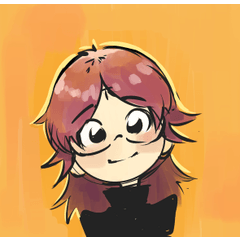Easy Comic-Like Shading with Masks
Introduction
In this tutorial I will show you how to achieve that soft and colorful look you see in most of the popular american comics. The use of masks will allow us to get it done in a much shorter amount of time. Wanna save some precious time when coloring? Then let's get started!
The Inks
The first thing you're gonna need for this is a black and white lineart/inks. It can be done in Clip Studio itself, although a scanned inked work will work just fine.
This will do, if you used a scanned image like I did, you may have to clean it up a bit using the brush tool, so you'll make the reference layer's work a bit easier (this is important)
Alright so if you're using a scanned picture, follow these steps for a clean and transparent lineart. If you drew the inks on Clip Studio itself, please skip to the Flatting part of the tutorial
We have the inks layer, but these are not transparent inks as you can see the white parts there. We're gonna use a pretty handy function called ''Convert brightness to opacity'' shown below
(Click Edit>Convert brightness to opacity)
Isn't that awesome? Now we have a transparent lineart, which is perfect if you wanna color it later, and reference layers work better with it.
Flatting
Flatting is, put simply, adding flat colors to a drawing. We're gonna start this by setting the Lineart layer as a reference layer. Simply click the lighthouse button as seen below.
Reference layers work as guides to other layers, it's specially useful for coloring. Now your wand tool and fill tools will select/fill following the ink layer. (provided you selected these options of course)
I use a combination of the paint bucket tools to fill in the flat colors, and then adjusting missing spots with a normal hard brush like the g pen brush.
Keep filling all the sections with flat colors! (make sure your color layers are placed below the inks) this may take a while but it is the most important step.
There, all flat colors are done now, and combined into a single layer. But this seems a bit...dull, right? Let's fix that
Our orc friend now has a darker color. Added some mud effects to the tire, designs on the orc's bandana and shirt and a fur pattern for the tiger. All in a separate layer.
As a last step in the flatting part, let's make a backup of our flat color and details layer.
I placed the copies of these layers in a folder named Backup (hey better safe than sorry). Now comes the fun part!
Shadows
For the shadows, we're gonna merge the details and flat color layers together. And then we duplicate the resulting layer. This layer will become the shadow.
In this new layer hit ctrl+u to summon the mighty Hue/Saturation/Luminosity window. (it can also be accessed by clicking Edit>Tonal Correction>Hue/Saturation/Luminosity.) Tone down the saturation just a bit, and lower the luminosity to a point you're comfortable with.
Now we're gonna use a layer mask to ''carve'' out the lights, so to speak. Make sure to also block the transparency of the layer as well by clicking the icons shown below.
Now we're gonna select the places that should be lighter, for that we're gonna use the Lasso tool, and ''paint'' with the Soft Airbrush tool. Make sure you select transparent color and not opaque color. (It can be done by pressing C while selecting a brush, or clicking the small rectangle under the two main colors)
See? What I'm doing here is ''deleting'' the shadow parts, but the mask allows me to paint it back exactly as it was. Pretty useful as we all make mistakes.
(Make sure you're selecting the mask and not the layer itself! Or you won't be able to correct mistakes easily)
Now our orc friend is fully shaded! Play with whatever brushes you like to create fun textures. I only used the airbrush here. Alright, time to do the lighting.
Lights
For this, we're gonna do the same process as the shadows, but slightly different. Duplicate your flat color layers again, and place this new layer above the shadows layer.
As seen above, we use Hue/Saturation/Luminosity again, this time boosting up the saturation and luminosity instead of darkening it.
We're gonna do the same as the shadows by locking transparency and masking this new layer. But we're gonna ''delete'' all of the lights using the layer mask.
After ''deleting'' the lights, bring them back with the same lasso and airbrush combination as shown below.
All the lights have been added and everything looks much more colorful and rich now. And with this tutorial you can avoid the pain of color picking each shadow and light, for faster results!
Finishing details
This a more subjective thing, but this will help you capture that comic-like look into your images.
I added two layers of rim light above all the other layers, in ''Add Glow'' mode (1). This is used by a lot of colorists for a dramatic and crisp lighting effect. I also added a color layer above the lineart, and set it to clipping mode so the lines will have some color to it (2).
Added a gray background, and it's all done.
Thanks
Well I hope this helped you somehow! Been using this time saving method for a while and I wanted to share it.
If you liked my work, follow me on IG
























留言